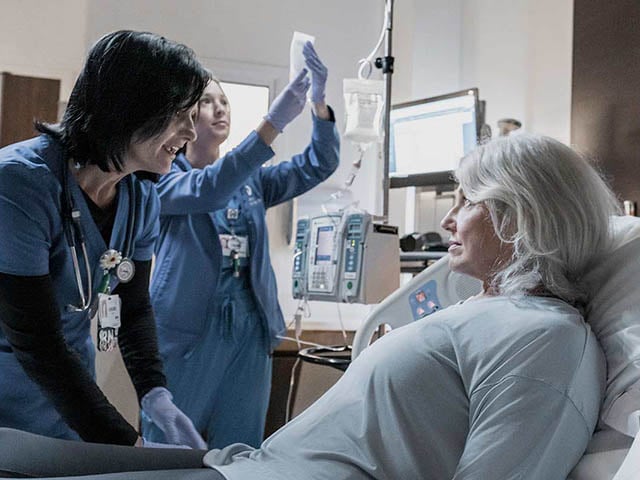Glioblastoma
The most common type of cancerous brain tumor, glioblastoma starts in the astrocytes, which are small, star-shaped cells found in the tissues that support the nerve cells of the brain. While glioblastoma can arise anywhere in the brain, it is most commonly seen in the frontal and temporal lobes of the cerebrum. Because astrocytes are fed by a large network of blood vessels, glioblastoma tends to grow quickly. Even so, these tumors rarely spread outside the brain.
Glioblastoma cells can vary widely in their genetic makeup. Because some treatments that can destroy one type of glioblastoma cells may have little to no impact on others, the diverse cellular composition of glioblastoma can complicate its treatment. Typically, a neuro-oncologist will combine several therapies into a single, comprehensive treatment plan, and then closely monitor the patient’s progress and adjust or refine the plan as needed.
Glioblastoma causes and risk factors
Scientists do not yet fully understand the causes of glioblastoma. Like most tumors, it forms when cells in the brain undergo harmful DNA changes. DNA provides instructions to control cellular proliferation, telling a cell when to grow, divide and die.
The DNA changes that lead to cancer tell the cell to replicate rapidly and live beyond its normal lifespan. This creates an abundance of abnormal cells that do not function properly. The abnormal cells then bind together, form tumors and eventually invade and destroy healthy tissues. Additionally, due to its critical location in the brain, glioblastoma may press on sensitive neural tissues, which can cause disruptive symptoms and complications.
In rare cases, glioblastoma occurs in people who have certain genetic syndromes, such as:
- Neurofibromatosis type 1
- Turcot syndrome
- Li Fraumeni syndrome
Researchers also believe the DNA changes that lead to glioblastoma may be triggered by the collective effects of repeated exposure to certain chemicals or high doses of ionizing radiation.

Glioblastoma signs and symptoms
The warning signs of glioblastoma can vary depending on the location and size of the tumor. Many symptoms are related to brain swelling and increased pressure in the brain. These can include:
- Headaches
- Seizures
- Drowsiness
- Nausea and vomiting
- Memory loss
- Personality changes
- Weakness on one side of the body
- Speech difficulty
- Vision changes
Glioblastoma diagnosis
The diagnostic process for glioblastoma may include:
- A neurologic examination - A physician will evaluate the patient’s vision, hearing, balance, coordination, strength and reflexes.
- Imaging tests - To determine the location and size of a glioblastoma, a physician may order magnetic resonance imaging (MRI), computed tomography (CT) or positron emission tomography (PET) scans.
- A biopsy - A physician will use a needle or perform a surgical procedure to remove a small sample of suspicious tissue for microscopic evaluation by a pathologist.
Glioblastoma treatment
The surgical treatment options for glioblastoma can include:
5-ALA guided tumor resection
Before a surgeon removes the glioblastoma, the patient will take a drug known as 5-aminolevulinic acid (5-ALA) by mouth. Healthy tissues in the patient’s body will metabolize the 5-ALA to a blood component (hemoglobin), but the cancerous cells will be unable to fully process it. As a result, 5-ALA will accumulate in the glioblastoma cells, causing them to glow or fluoresce under blue light. Using a specially modified surgical microscope, the surgeon will turn a blue light on and off during the procedure to clearly visualize the tumor boundaries and guide the excision.
Awake craniotomy
While the patient remains conscious, a neurosurgeon will use special mapping techniques to identify areas of the brain that are activated during speech and movement. While applying a mild electrical current to the exposed brain, the neurosurgeon will ask the patient to speak or read. If the electrical stimulation affects the task, the surgeon will preserve the corresponding area of brain tissue when removing the tumor.
Convection-enhanced delivery
Usually, any cancer-fighting drugs circulating in the bloodstream cannot penetrate the blood-brain barrier (BBB) and therefore cannot reach the brain. To circumvent the BBB, a neurosurgeon may use a technique known as convection-enhanced delivery, which involves placing a catheter in a brain tumor, and then slowly pumping medication directly into the cancerous tissues.
In addition to surgery, other treatment options for glioblastoma include stereotactic radiosurgery, intensity-modulated radiation therapy (IMRT), oral and intravenous chemotherapy and immunotherapy.
Frequently asked questions (FAQs) about glioblastoma
The best source of information about glioblastoma is an experienced neuro-oncologist who is familiar with the case. When learning about the condition, however, many patients find the following FAQs to be helpful:
- What is glioblastoma?
- Is glioblastoma hereditary?
- Does glioblastoma display different symptoms than other brain tumors?
- What does a glioblastoma headache feel like?
- Is glioblastoma curable?
- Five long-term effects of glioblastoma treatment
Benefit from world-class care at Moffitt Cancer Center
Moffitt offers both traditional and cutting-edge treatment options for glioblastoma, including a robust portfolio of clinical trials. Our multispecialty team takes an individualized approach to treatment with the goal of helping each patient achieve the best possible outcome and quality of life.
You can request an appointment with an expert in our Neuro-Oncology Program to discuss glioblastoma by calling 1-888-663-3488 or submitting a new patient registration form online. We do not require referrals.

